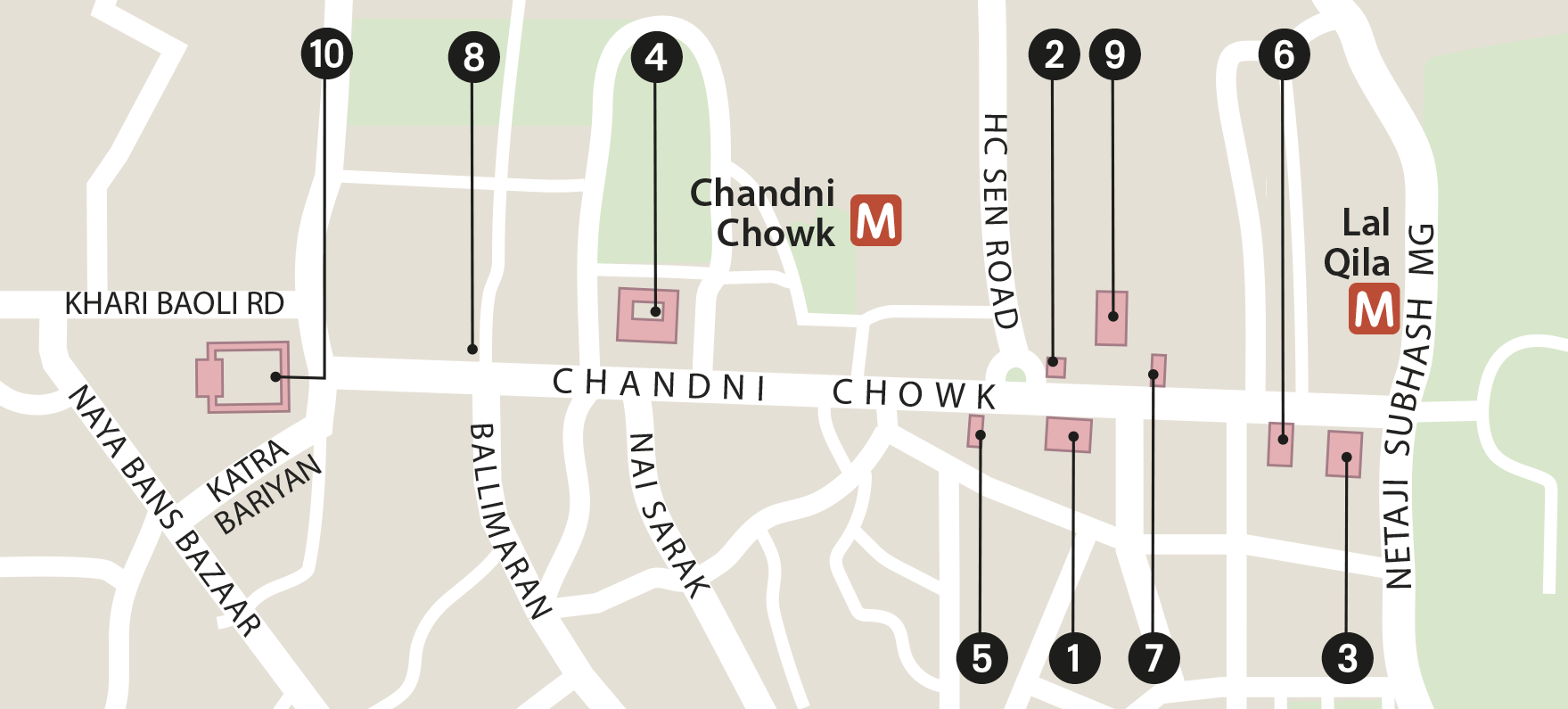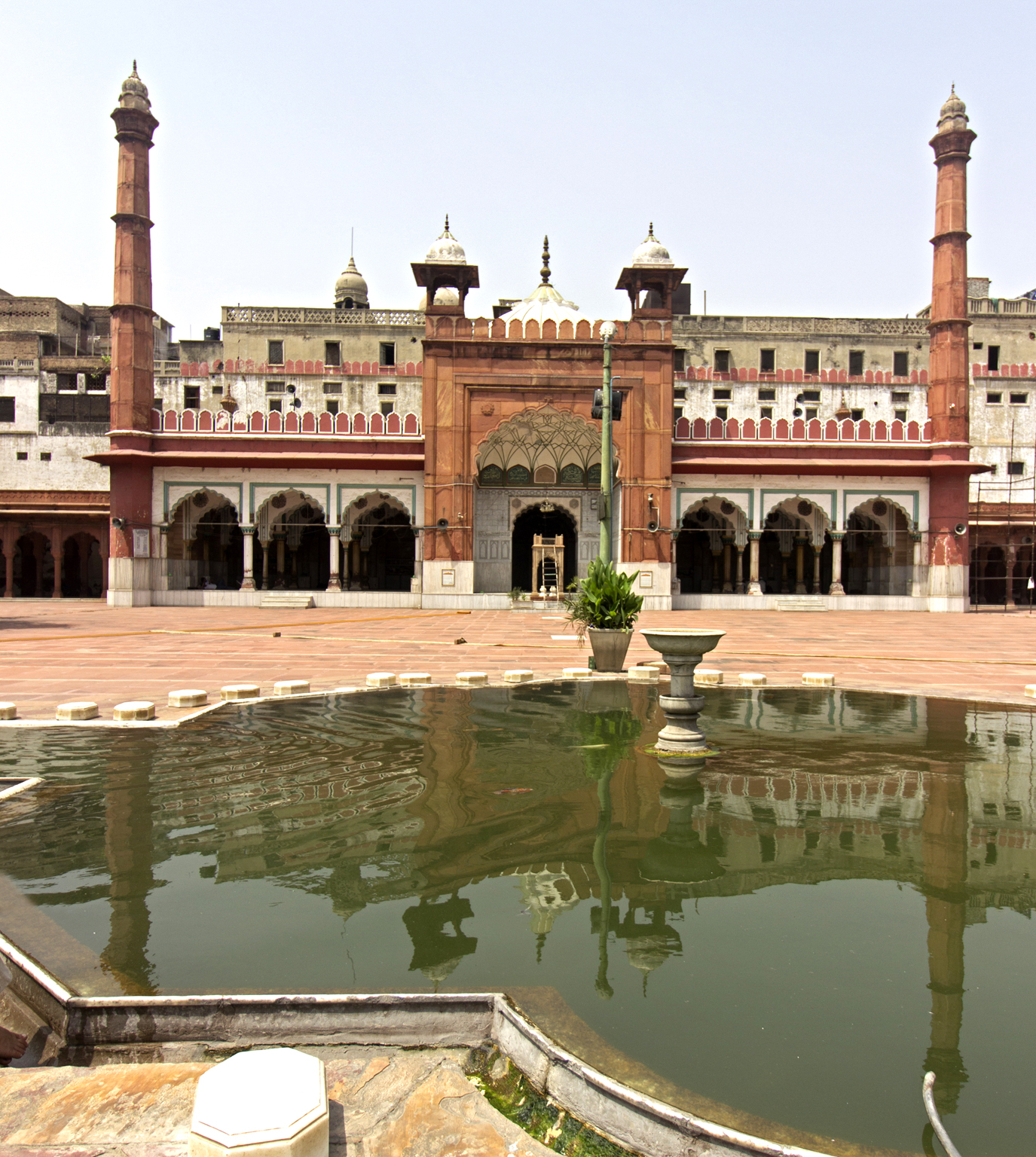
CHANDNI CHOWK
When Shah Jahan built his new city, Chandni Chowk was planned as its principal thoroughfare – a broad, ceremonial avenue leading directly from the Red Fort and a favoured spot for elaborate processions. Most of the street’s original buildings are now gone (along with the canal which ran down the middle of the road), but Chandni Chowk, lined with shoebox shops, and eternally bustling with crowds and traffic, retains much of its traditional atmosphere.

Narrow streets lined with shops in Chandni Chowk

Chandni Chowk
NEED TO KNOW
 Chandni Chowk Metro; Lal Qila Metro
Chandni Chowk Metro; Lal Qila Metro
- The pavements of Chandni Chowk are busy and congested, made worse due to ongoing construction. A rickshaw ride along the road is a fun way to experience this lively area without constantly having to check what’s up ahead.
- Head to Haldiram’s for a light meal, or get a tasty parantha from the Paranthe Wali Gali.
1. Gurudwara Sisganj
This large, modern Sikh temple commemorates the spot where the ninth Sikh guru, Teg Bahadur, was beheaded on the orders of Mughal emperor Aurangzeb in 1675.

The modern Gurudwara Sisganj
2. Bhai Mati Dass Museum
The museum provides a comprehensive history of the Sikhs in pictures, including some portraits of the ten Sikh gurus.
3. Lal Mandir
Built during the reign of Shah Jahan for the Jain soldiers in his army, the Lal Mandir (Red Temple) is one of Delhi’s principal Jain shrines. Made of red Kota stone (hence the name), the temple’s towers are major landmarks at the fort end of Chandni Chowk.
4. Town Hall
The elegant British Town Hall built in 1864, stands out from cluttered buildings of Chandni Chowk.

The refined Delhi Town Hall
5. Sunehri Masjid
This small Mughal mosque (1721) was named for its gilded domes (sunehri meaning “golden”). It was from here that Persian invader Nadir Shah watched his soldiers massacre the city’s inhabitants in 1739.
6. Gauri Shankar Mandir
Created for Shankar (Shiva) and Gauri (his wife Parvati), this vibrant Hindu temple features an ancient lingam, a symbol of worship of the god Shiva; it is said to be around 800 years old.
7. Central Baptist Church
The first Christian mission in northern India when it was founded in 1814 (although the current building dates from 1858), this modest church is an atmospheric memento of the Raj era.
8. Lala Chunna Mal’s Haveli
Built by Hindu merchant Lala Chunna Mal, who had made a fortune supplying British forces in the 1857 Uprising, this sprawling, balconied mansion has no fewer than 128 rooms.
9. Begum Samru’s Palace
Half-buried in the middle of a crowded bazaar just off the main street, this huge Neo-Classical mansion (now occupied by the Central Bank of India), was once one of the grandest buildings in Delhi. It was built back in 1823, and had gardens which stretched all the way to Chandni Chowk.
10. Fatehpuri Masjid
Located at the far west end of Chandni Chowk, the Fatehpuri Masjid was built by a wife of Shah Jahan in 1650, and has an enormous and wonderfully peaceful courtyard.

The grand Fatehpuri Mosque
CHAINA RAM
Sadly, Chandni Chowk’s most famous sweet shop, Ghantewala, established in 1790, closed in 2015. But sweet lovers won’t go hungry, because at the street’s western end, Chaina Ram, founded in Karachi in 1901, makes the best halwa in India. Its Hindu owner was forced to flee Pakistan in 1947, but in what amounts to a statement against sectarianism, he set up in Delhi’s most Muslim neighbourhood.


